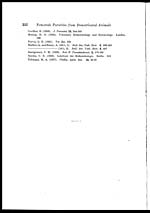Medicine - Veterinary > Veterinary colleges and laboratories > Indian journal of veterinary science and animal husbandry > Volume 9, 1939 > Original articles > Report on two unrecorded nematode parasites from domesticated animals of India or Burma
(239) Page 331
Download files
Individual page:
Thumbnail gallery: Grid view | List view

R. C. CHATTERJI 331
muscular and glandular portions of oesophagus bending round the oesophagus,
joining afterwards with the two uterine tubes. Tail slightly coiled, ending
in a blunt, slightly swollen termination provided with irregular papillae-like
projections: in some cases where the tail end was contracted the papillae
were not conspicuous but the rugged and ' shagreened' nature of the tip
was clearly noticed. Eggs oval and at primitive stage 0.026-0.031 × 0.015-
0.018 (according to Bernard and Bauche 0.038 × 0.018), developing into
embryos which are finally liberated in the uterus.
Sandground [1933] considers S. bernardi identical with S. congolensis,
the reasons for his belief being the identical nature of the caudal papillae and
the more or less equal lengths of oesophagus and spicules. S. congolensis
have four pairs of large postanal and three pairs of small preanal papillae,
the reverse is the condition in S. bernardi and in addition to which there is
one pair of adanal papillae, which is probably equivalent to the fourth pair
of postanal papillae of Bernard and Bauche. The glandular portion of the
oesophagus in the former varies from 13-16 where body-lengths of male and
female are 8 cm. and 11-14 cm. respectively, but in the present form, where
lengths of male and female are 9-10 cm. and 15-18 cm. respectively, the length
of glandular oesophagus is 8.6-10. Moreover, the spiny nature of the right
spicule and the peculiar shape of the left spicule with its comparatively long
flaggellated end, omitted by Bernard and Bauche and also by Sandground
are additional differences from S. congolensis. The author having found the
characters of the spicule so different from those described by Bernard and Bau-
che and also by Sandground,—and the structure of the caudal end of the male,
being the only reliable character on which specific differences can be based,
it having been shown by Purvis [1931] and Baylis [1936] that the head ends of
Setaria and also the caudal ends of the female are so changeable—he felt
inclined to consider his material as a new species. In view of Sandground's
statement that " in ordinary cleared specimens the measurement particularly
of the left spicule with its tapering flagelliform distal end is a matter of diffi-
culty and that reliable measurements were only to be secured from specimens
that have been subjected to prolonged clearing action of hot lactophenol",
no stress should be laid on differences in length and shape of the distal portion
of the left spicule, a contention substantiated by the present specimens. The
failure by Sandground of any mention of spines on the right spicule can be
attributed to the same reason. It thus appears that the present material
is identical with S. bernardi but is specifically distinct from S. congolensis.
REFERENCES
Alicata, J. E. (1937). Hawaii. Agric. Expt. Stn. Cir. No. 11, 1-7
—(1938). Livro Jub. Prov. Lauro. Travassos. 11-19
Baylis, H. A. (1929). A Manual of Helminthology, London, 251
—(1936). Ann. Trop. Med. Parasitol. 30, 293-298
Bernard, P. N. and Bauche, J. (1911). Bull. Soc. Path. Exot. 4, 482-485
Boulenger, C. L. (1921). J. Parasitol. 12, 341-349
Cram, E. B. (1927). U. S. Nat. Mus. Bull. No. 140, 226-227
— (1931). U. S. Dept. Agric. Tech. Bull. No. 227, 8-13
Set display mode to: Large image | Zoom image | Transcription
Images and transcriptions on this page, including medium image downloads, may be used under the Creative Commons Attribution 4.0 International Licence unless otherwise stated. ![]()
| Permanent URL | https://digital.nls.uk/75247153 |
|---|
| Description | Covers articles from 1939. Please note that pagination starts at p.139 and plates at Plate V. |
|---|




